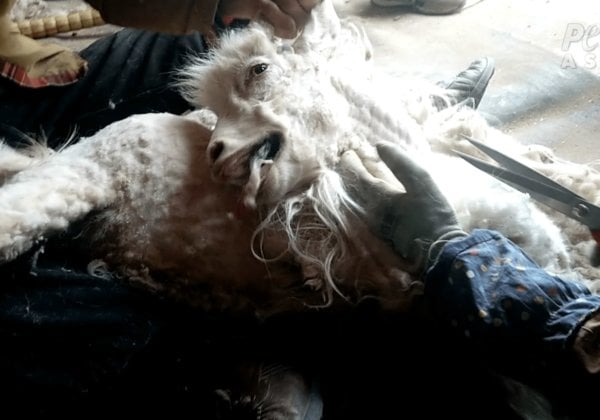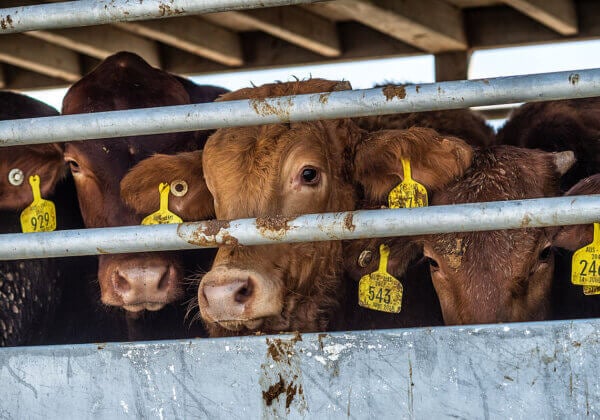The Mohair Industry
Mohair – the long, smooth fibre used in sweaters, hats, and other fluffy accessories – comes from angora goats (leading many to confuse it with angora wool, which comes from angora rabbits). Most of the world’s mohair originates in Lesotho (a country in southern Africa) and the US (particularly Texas), where angora goats are bred primarily for their soft inner coats, which are generally shorn twice a year, beginning as early as six months after birth. The survival and well-being of these sensitive animals are dependent on many particular conditions, including precise nutritional requirements, which are commonly not fulfilled on mohair farms.
Workers dehorn kids at the age of 1 or 2 weeks, typically by burning their horns off with a hot iron or applying a caustic chemical paste, which causes them to rub or scratch their heads in pain, potentially resulting in severe burns or blindness if the paste is transferred to their skin or eyes. Males also endure painful testicle removal using rubber rings, which leaves them in distress for days and often leads to tetanus infection. These procedures are usually carried out without any pain relief.

In order to obtain mohair, workers often tie the goats’ legs together, pin the animals to the floor, and use electric shears or large clippers to shear them. Since goats are prey animals, being restrained in this way is a horrifying experience for them. And because workers are paid per animal shorn and not by the hour, they work fast, causing the same frequent injuries and gaping wounds associated with sheep shearing.

After being shorn, angora goats are often crammed into transport trucks and forced to endure long trips – either back to the farm or to an abattoir – without their protective coats. Shearing robs them of their natural insulation, and unlike sheep, they don’t carry layers of body fat. They’re easily susceptible to internal parasites and cold temperatures, experiencing high mortality rates if left without shelter for four to six weeks after shearing, as they often are. They’re so sensitive that summer winds and rain can kill them even when temperatures aren’t low, and shearing them in the winter causes many to die of pneumonia. When they suffer from hypothermia, they’re also vulnerable to infections, nutritional deficiencies, and other often fatal problems.

Angora goats used for mohair are killed well short of their natural 10-year life expectancy – as soon as they’re no longer useful to the industry because they can’t reproduce or because drought, illness, or a couple of years of rough shearing have reduced the quality or regrowth rate of their hair. They’re often shorn one final time before being sold for meat, or they may be slaughtered for their skins, which are used to produce clothing, rugs, and other items. Buyers cram the animals into trucks for transport to the abattoir and may drive for as long as 35 hours to get them to market as quickly as possible. At the abattoir, they’re killed by captive-bolt gun, electric shock, or direct throat-slitting, which can cause them to suffer for up to 10 seconds while still fully conscious.

As mohair sales increase, the market for angora meat also expands – particularly for kid meat, known as capretto. Goats’ flesh may also be labelled “chevon” in meat markets in an attempt to portray it as a European “delicacy”. Therefore, if you purchase mohair, you’re supporting an industry that raises and slaughters goats for meat.
Mohair production is also a drain on resources and environmentally destructive. In order to produce about half a kilogram of mohair, goats must be fed between 18 and 23 kilograms of high-quality feed grown on land that could instead be used to grow crops to feed humans. Land degradation as a result of “overstocking” and “overgrazing” is also common – particularly in Lesotho, the second-largest mohair producer, where government regulations related to animal agriculture are poorly enforced.

There’s no excuse for supporting an industry that abuses and kills millions of goats every year, especially when there are plenty of warm, cosy, and stylish fabrics available that aren’t made from mohair or wool. Please join the millions of people all over the world who know that compassion is in fashion. Leave animal hair and skins out of your wardrobe, and join the vegan fashion revolution today.







